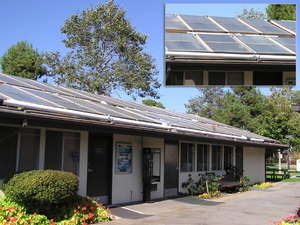
- Image via Wikipedia
According to a new report called 2009 Nielsen Energy Audit, compiled by market research specialist The Nielsen Company, saving money is one of the top motivating factors driving the adoption of green energy options. 80% of the 32,000 respondents polled cited cutting costs as their main motivation for conserving energy.
“The current momentum surrounding green initiatives and reduced energy consumption presents utilities and home improvement companies with a golden opportunity,†says Jonathan Drost, Account Executive, Energy for The Nielsen Company. “When going green is cost effective, such as opting for Energy Star appliances or government incentive programs, customers migrate in that direction. The biggest hurdle for energy companies is educating the consumer on things like Smart Grids, Energy Efficiency programs and Renewable Green Energy.â€
Solar appears as the number one preference as a carbon neutral source of energy, with 37% of the total. “I believe solar came out on top as a preference because it is a technology that consumers can identify with,†Drost offers. “Not only can a consumer place solar panels on their home or purchase solar water heaters, but also they see retailers installing solar panels on their roof and hybrid cars with solar roof options. It’s been a media hot topic as well.†32% of the respondents expressed no preference, followed by 16% who cited wind as their top preference. Geothermal accounted for 5%; hydroelectric, 4% of preferences.
California, Texas, New York and Oregon boast the largest percentage of consumers who participate in a green energy program. In terms of regions, the west (consisting of California, Oregon and Washington), with a 24% rate of participation, is the greenest area in the country. This is explained by the fact that California has had green pricing programs in place for many years.
Age and income also play a role in green energy participation, which is better among the higher educated and those making over $50,000. However, a higher proportion of those making between $50,000-$100,000 (34%) participated compared to those making more than $100,000 (30%). Participants also skewed younger, with 40 percent falling between the ages of 18-34 and 39% in the 35-54 year age range. Those above 55 make up 20 percent of those taking part in green programs.

![Reblog this post [with Zemanta]](https://img.zemanta.com/reblog_e.png?x-id=d57b098e-173d-4607-89a4-b7a91d53d66f)





It’s too bad that we thought of it before the issue of global warming came up. But it’s never too late, I guess. Besides low-priced energy, there are state rebates and federal tax credits offered to those with green energy sources. Also, we lessen our dependency on foreign energy.
This post reminds me of two things:
1. People would always think of ways to make and save money and;
2.People are now thinking about the environment more and more